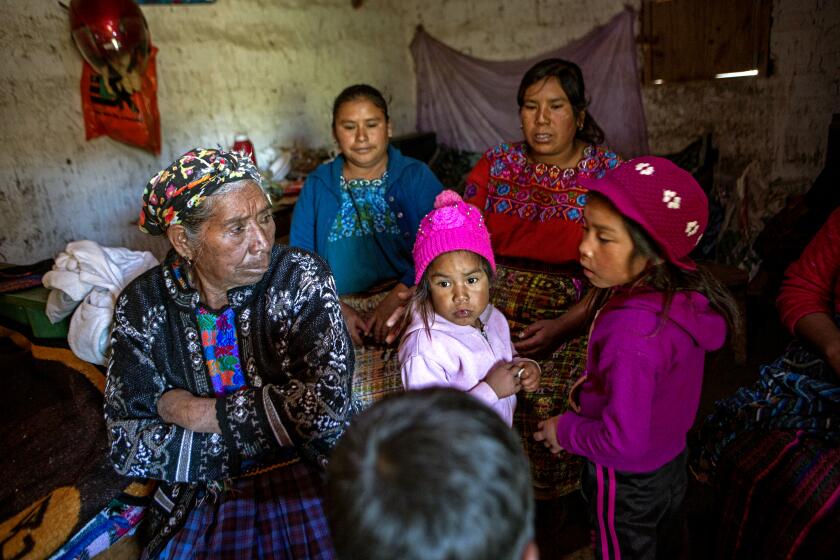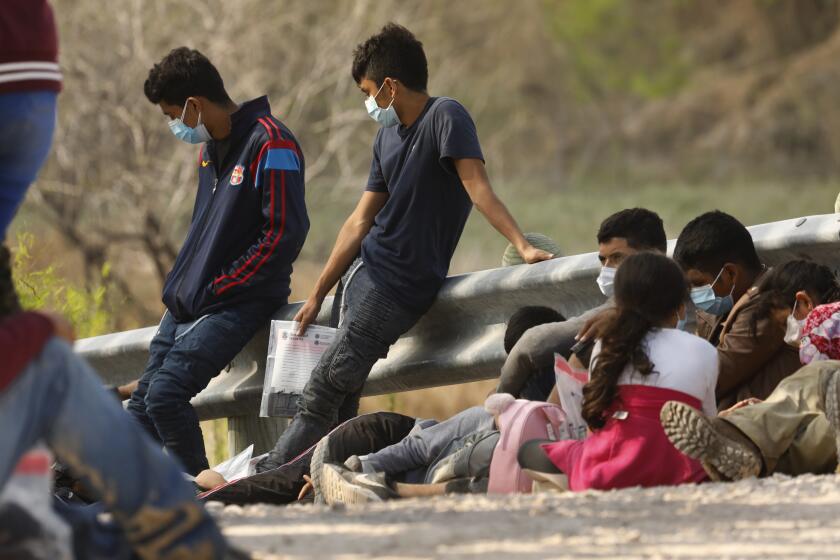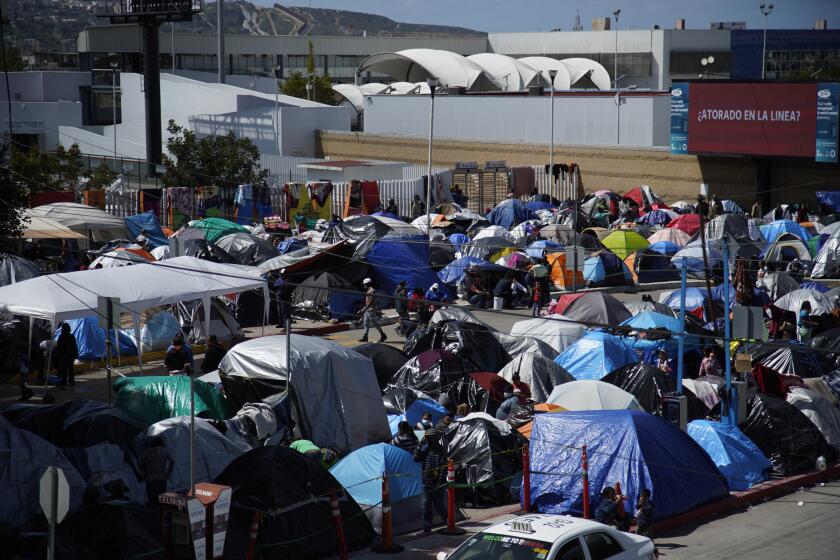Mexico cracks down on its own southern border as U.S. faces migrant pressures

- Share via
CIUDAD HIDALGO, Mexico — The banks on the Mexican side of the Suchiate River were crowded Sunday with immigration agents sent to enforce Mexico’s new limits on all but essential travel at its shared border with Guatemala.
Dozens of agents lined the riverside asking for documentation from those who came ashore aboard the giant innertube rafts that carry most of the cross-border traffic. Many were turned back.
But many of those who were turned away weren’t migrants. They were the small-time Guatemalan merchants and residents from Tecun Uman, across the river, who buy items in bulk in Mexico to resell in Guatemala or purchase household goods when the exchange rate is favorable.
“They haven’t let us enter because they think we’re migrants when really we’re only coming to shop,” said Amalia Vázquez, who had a baby tied to her back and seven other relatives accompanying her. Vázquez said her family travels the 60 miles monthly from Quetzaltenango to buy the plastic goods and sweets that they resell at home.
After a negotiation, immigration agents allowed her sister and another relative to pass, but they had to leave their IDs with agents while they shopped. Nearby, other agents turned away a man who said he was just coming to buy his medicine.
The Mexican government has previously interrupted the usually free-flowing cross-river traffic here, infuriating merchants on both sides. In recent years, as migrant caravans arrived in Tecun Uman, Mexican troops lined the Mexican side of the Suchiate and largely stopped the raft traffic.
Nineteen burned bodies are found in an area in northern Mexico near the U.S. border that has a long history of horrific violence against migrants.
The last time was in January 2020, when hundreds of soldiers blocked large groups of migrants trying to cross.
This time there is no large migrant presence across the river, but Mexico is again under pressure to slow the flow of migrants north as the U.S. government wrestles with growing numbers of migrants on its own southern border, especially families and unaccompanied minors.
Many of those are believed to have traveled with smugglers who can choose among the hundreds of unmonitored crossing points along Mexico’s long jungle borders with Guatemala and Belize.
The Mexican government said the measures that went into effect Sunday were aimed at slowing the spread of the coronavirus. But most saw it as an attempt to control illegal migration, and no one was talking about health concerns. The U.S. and Mexico have had a similar limit on nonessential travel on their shared border for a year, but Mexico is one of the few countries that have not imposed health restrictions on people entering the country by land or air.
The Biden administration says migrants can still get protection under a Trump-era pandemic policy. But in a year, fewer than 1% have been able to do so.
“There’s no reason that this would help public health,” said Yuriria Salvador of the Fray Matías de Cordova Human Rights Center in Tapachula, Mexico. ”It comes from the negotiation with the United States — it’s very clear.
“What is going to happen is that they’ll be pushed more into secrecy and the trafficking of people,” Salvador said.
Juan José Ramírez, a Guatemalan who crosses into Mexico daily upriver at the Talisman crossing, said he didn’t note any change Sunday at that port of entry.
“They only asked for my border visitor card, but the taking of the temperature and all of that they stopped awhile ago,” he said. “It was only at the beginning [of the pandemic], when it was worse.”
Breaking News
Get breaking news, investigations, analysis and more signature journalism from the Los Angeles Times in your inbox.
You may occasionally receive promotional content from the Los Angeles Times.
The Mexican government last week also announced a new effort to stop the smuggling of families with minors. They said they would increase patrols in areas and checkpoints and use drones and night vision to watch crossing points.
On Saturday, Mexico’s immigration agency announced that authorities had detained 95 Central American and Cuban migrants who arrived by plane in the northern city of Monterrey. Among them were eight unaccompanied minors. The flights originated in southeast Mexican cities, Villahermosa and Cancun. Smugglers sometimes put migrants who can pay on such flights to avoid highway checkpoints in Mexico.
On Friday, hundreds of Mexican National Guard troops and immigration agents paraded through the capital of the southern state of Chiapas. On Sunday, few soldiers were visible along the river.
“It’s all a show,” said a woman with a sweets stand in the market, who asked to remain anonymous to avoid retaliation. “They don’t let the ones coming to buy pass, but the smugglers are very active.”
While President Biden has taken steps to change Trump administration asylum policies, many are still in effect to keep asylum seekers out of the U.S.
Mexico’s National Immigration Institute says smugglers are telling Central American migrants to bring children to improve their chances of entering Mexico and the U.S.
The flow hasn’t reached early 2019 levels yet, but the U.S. government is worried by the rapid increase in illegal entries since last fall.
“It isn’t much that we take for reselling,” said María Vázquez, Amalia’s sister, as she negotiated the price of some cookies while her family waited by the river. “The migrants traveling in groups really harm us and the pandemic, too.”
More to Read
Sign up for Essential California
The most important California stories and recommendations in your inbox every morning.
You may occasionally receive promotional content from the Los Angeles Times.















